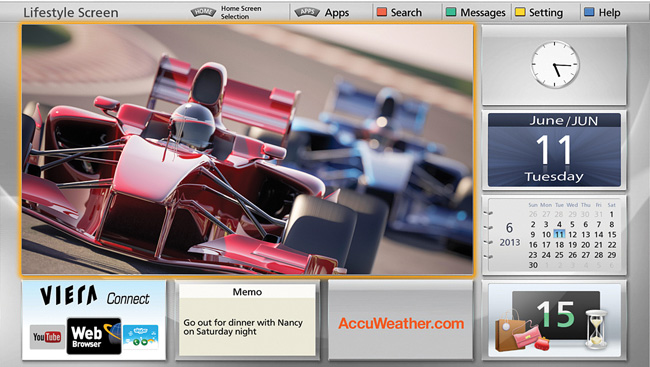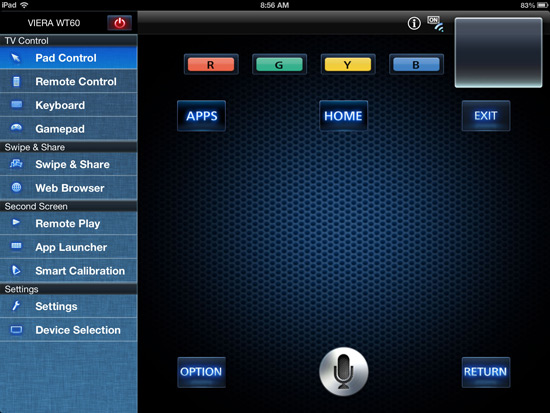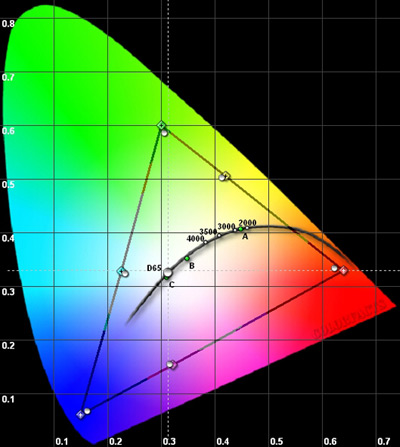To see how far LCD TVs have advanced in recent years, one need only look at Panasonic's TC-L55WT60 55" LED-lit LCD TV, which is a good showcase of new technologies and features in the category.
Although Panasonic dubs the set as an LED TV, that's not quite accurate, as the imaging panel itself is LCD-based (to be fair, other makers also do this). Strings of LEDs along the panel edges light up the LCD panel, in lieu of the now mostly obsolete fluorescent tube backlighting method. Along with a substantially thinner cabinet depth, the bezel that wraps around the panel is similarly shrunk, and is about the thickness of a standard pencil.
With fluorescent tube-based LCD sets, true deep blacks are simply unattainable (the best you can get is a dark gray). That's not a problem for the Panasonic, which employs a system of LED sub-section strings that are modulated (dimmed and brightened) in rows according to the image content. Panasonic calls the technology 4200 Back Light Scanning, which works in conjunction with the 240 Hz panel refresh rate to deliver a sharper picture with fast motion scenes along with better blacks.
The TC-L55WT60 is packed with smart TV features, and includes built-in Wi-Fi (there's also a LAN port for a direct connection), and it comes pre-loaded with a good range of apps, including the major content streaming services such as Netflix, Vudu, Amazon, Hulu Plus, Pandora and Cinema Now (more streaming service apps are downloadable from Panasonic).
A pop-up camera on the top of the set is useful for Skype video calling (the app is pre-installed), and it can be used to record video messages to family members. The facial recognition feature lets each family member customize their own home screen, and receive their video messages.
The TV also supports voice recognition, and comes with two remotes. The main remote is a conventional looking affair, while the second remote features a touchpad and microphone for cursor navigation and voice recognition.
The Setup
The setup process took only a few minutes, with a wizard offering me a choice of home screen layouts and the ability to customize these with favorite apps or widgets. The built-in Wi-Fi found my home network and connected to it quickly, once I entered my passcode. The touchpad remote, which works mainly via Bluetooth (only the power on/off function works via IR), paired quickly on the first try.

Connectivity
There are 3 HDMI inputs (one supports Audio Return Channel) and 3 USB ports. There's a combo composite/component input with stereo audio, and an optical digital audio output (but no analog audio output). There's an SD card slot, and an RJ-45 LAN port along with the RF input to round out the connectivity package.
Remote Controls

The cursor pad is surrounded by 3 buttons, to access the apps, the home screen and input selection. However, they're fairly close to the cursor ring, and I found that when using the cursor ring to navigate around the screen I would inadvertently hit one of the three buttons, taking me to a place I didn't intend to go to.
The remote can control some components via HDMI CEC, which they call "VIERA Link," but it didn't recognize my DISH Hopper DVR, so the skip back and forward buttons on the Panasonic remote wouldn't work.
The second remote features a touchpad with a ring around it with 4 buttons, including one for the voice recognition feature. The back of the remote has a trough indent for your finger, with a button that's used for enter/confirmation.
The voice recognition feature worked quite well, to my surprise and delight. If you speak too loudly into the microphone, the TV will let you know, and there's a multi-bar voice level indicator on the screen to help. Once activated, the screen fills with a number of typical command suggestions with asterisks that you fill in by voice. I asked to "Search for YouTube videos" and within a moment or two the Google main page came up with YouTube as a second choice. I then asked to find specific YouTube music videos by either artist name or song title or both, and with each of the dozen or so searches I tried, the TV responded appropriately. Very impressive.
The cursor keypad on the small remote communicates with the TV via Bluetooth, but getting around the screen isn't as smooth as it would be with a dedicated mouse (or laptop touchpad). It's a bit jerky, and it's all too easy to accidently touch the pad with the intention of moving the cursor around a bit and wind up with the remote performing an enter command instead.
To see how well I could control the set with my iPad, I downloaded the Panasonic Viera Remote2 app, and it is a superbly designed app (there's an Android version as well, but since my el-cheap Android phone isn't 4.0, which is a requirement, I couldn't try it out). The app let's you do virtually anything with the TV that either remote will do, and it even opens up additional control possibilities, including accessing ISFccc calibration controls. Definitely a must-have app with this TV.
With the app, you can upload content from your smartphone or tablet to the TV via the Swipe and Share function, and similarly download content from the TV to your device. However, the function only works by accessing content on a USB thumb drive plugged into the TV and similarly with compatible content already pre-loaded on your device. It does not allow live TV streaming/mirroring to your phone or tablet, and is incompatible with iTunes content (no surprise there). The TV does have DLNA 1.5 compatibility though, so accessing content from your PC is also possible.

There's one downside to having a Panasonic web-connected TV, and that's pop-up ads which appear when the TV is turned on. But if these bother you, they're easy enough to turn off. Just go to: "Set-Up... Display Customization... Viera Connect Banner" and switch that to OFF.
On Screen Display
Navigating around the windowed screen is fairly straightforward, but I found myself using the iPad app to do most of the remote work, especially as I could use the iPad's virtual keyboard to enter web addresses and the like. After a few days, the set must have been paying attention to my behavior as it decided (by itself, with no input from me), to default to the full screen display on startup, with a small button strip along the screen top to access the apps and such which disappears after just a few seconds.
The Analyzer Speaks
Some Panasonic TVs have come with ISF certification, and some others have had THX certification (both have stringent requirements for display quality). Although the TC-L55WT60 has neither certification, I've found that non-certified TV models from a brand that supports either or both certification programs very often do have the ability to deliver picture performance that's similar if not identical to one that is certified. Such is the case with this Panasonic.
I first disabled or minimized all of the picture enhancement functions, including the C.A.T.S feature, which is Panasonic's "eco" mode. I then found that, not surprisingly, the Cinema mode delivered the best overall performance. The Warm2 color temperature mode provided the most accurate color temperature values and gray scale tracking performance (it's automatically selected when the Cinema mode is chosen).
Overall, I'd give the Panasonic an A-minus score, compared to other LCD TVs I've measured, which is excellent indeed. A full-on calibration could improve some things here and there a smidgen, but the before and after visual differences would be subtle at best, perhaps even unnoticeable.
2D Performance

To gauge flesh tone accuracy, I go right to live HD programming, usually one of the network national news shows. With the Panasonic set to the Cinema mode and the color temperature set to Warm2, an NBC evening news broadcast confirmed that the TC-L55WT60 delivers natural and believable flesh tone accuracy.
I also watched "Forrest Gump" on HBO via DISH Network, a movie I hadn't seen in ages, and was highly pleased with how it looked on the Panasonic. The movie's color palette is nicely rich, but not overly so, and there were many nighttime scenes that looked just great, with nice deep blacks and discernable shadow detail.
The end credits of the movie sealed the deal, just simply white text scrolling against a black background. With early generation LED backlit LCD sets, there would always be a soft white halo around the text, but with this Panasonic display, there was none. The text was clearly etched against the totally black background, with no visible haloing.
With the FPD Benchmark Software Blu-ray disc, I viewed static and moving high resolution test patterns, and found that the Motion Picture Setting feature (which provides detail enhancement with moving images) performed best when at the Mid setting.
3D Performance
When I first unpacked the set (which comes with 4 pairs of 3D glasses), I did a big "Uh-Oh". Although previous 3D Panasonic TVs I'd tested were of the active shutter 3D format, the TC-L55WT60 is of the passive polarized type, which doesn't provide full resolution as does the active shutter 3D approach, which I prefer.
While passive polarized 3D does have advantages over active shutter 3D (cheaper to implement in the TV and much less costly 3D glasses that don't need batteries or re-charging), the drawback is that vertical resolution is halved, with visible scan lines, occasional jaggy edge artifacts on curved edges and loss of detail on fine picture elements (such as small font text).
Just for fun, I tried Panasonic's own 3D promotional Blu-ray disc, produced at the time when 3D TVs first appeared on the scene. The disc is a combination infomercial for active shutter 3D and a collection of 3D clips and still images.
The 3D effect I experienced with the TC-L55WT60 was generally quite good, although at a normal viewing distance the scan lines were plainly visible, and I noted the occasional jagged edges on soft curves. One of the chapters on the disc features 3D still images, and the small logo and website text of the company that produced them on the lower left of each image was illegible due to the loss (halving) of vertical resolution that comes with passive 3D.
The TC-L55WT60 also has 2D-to-3D upconversion, and I tried out the feature with the stop-motion animated feature "Wallace & Gromit: Curse of the Were-Rabbit" (HBO2 via DISH Network), as 2D animation features usually fare better with 3D upconversion, and that was the case here, with the Panasonic delivering a mild but pleasant 3D effect.
Recommended Picture Settings
Choose the Cinema mode for the most accurate color palette along with the Warm2 color temperature mode for the most neutral whites. With the Motion Picture Setting function activated, I found the best results when it was set to the Mid setting. Turn Overscan to Off to achieve full 1920x1080 resolution, along with the Horizontal Size set to 1.
Turn Ons
Turn Offs
Final Thoughts
The TC-L55WT60 is a very good example of just how far LCD flat panel displays have evolved over the last half dozen years. It delivers a crisp picture along with accurate colors, and past LCD bugaboos such as noticeable motion smear are ameliorated if not eliminated.
It comes with two remote controls, so you can choose to begin with the standard button-type remote, and then graduate to the touch pad remote with the voice recognition feature. The built-in browser isn't as zippy as a desktop or laptop computer's browser, but it's quick enough. The voice recognition feature works well, and the array of built-in apps can be expanded via downloads. The iPad app is a must-have, and adds to the ease of control of the TV, especially during picture adjustments, as you can make changes while viewing full screen images.
At a list price of $3,000 (ok, it's 2,999.99), it's a little on the pricey side (these days, I use the $100/$50/$25 per diagonal inch rule - $100 per inch is high indeed, $50 per inch is somewhat pricey, and $25 per inch is a very good value if the performance of the set is up to par). At the discounted price of $2,500 however, the TC-L55WT60 falls below the $50 per inch threshold, so given its performance and feature set, I consider it to be a good value.
Specifications: Panasonic TC-L55WT60
Manufacturer's Contact Information:
Panasonic Corporation of North AmericaWhere to Buy:
| Overall | |
|---|---|
| Value | |
| Performance | |
| Features/Ergonomics |